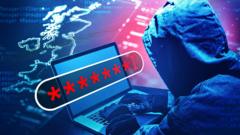Could a Weak Password Sink a 158-Year-Old Company?

The Rising Threat of Ransomware: A Closer Look at KNP's Collapse
In a world increasingly reliant on technology, the devastating impact of cybercrime is becoming alarmingly apparent. The recent collapse of KNP, a 158-year-old transport company, serves as a stark reminder of how vulnerable businesses can be to ransomware attacks. With 700 employees left without jobs, this incident highlights the urgent need for enhanced cybersecurity measures across all sectors. As ransomware gangs become more sophisticated, understanding the risks and implementing preventive strategies is more crucial than ever.
Understanding Ransomware: What Is It?
Ransomware is a type of malicious software designed to block access to a computer system until a sum of money is paid. It operates by encrypting files on the victim's computer, rendering them inaccessible. The attackers then demand a ransom in exchange for the decryption key. This method of cyber extortion has become alarmingly prevalent, with businesses of all sizes falling victim to such attacks.
The Mechanics of Ransomware Attacks
Ransomware attacks typically follow a series of steps, which can involve:
- Infiltration: Hackers gain access to a company's network through various means such as phishing emails, exploiting software vulnerabilities, or even social engineering tactics.
- Encryption: Once inside, the ransomware encrypts files, effectively locking the organization out of its own data.
- Ransom Note: The attackers leave a ransom note detailing the payment required to restore access to the data.
- Negotiation: Some companies may attempt to negotiate the ransom amount with the attackers.
The Case of KNP: A Cautionary Tale
KNP's downfall illustrates how a single compromised password can lead to catastrophic consequences. The transport company, which operated 500 lorries, was believed to have adhered to industry standards for IT security and even had cyber insurance in place. However, the hackers, known as Akira, managed to infiltrate their system, causing complete operational paralysis.
The Role of Human Error
One of the most troubling aspects of KNP's situation is the role of human error in the attack. A weak password allowed hackers to gain entry, highlighting that even the best security measures can be undermined by employee negligence or lack of awareness. KNP's director, Paul Abbott, refrained from informing the employee about their compromised password, raising ethical questions about accountability and awareness in cybersecurity.
Impacts Beyond the Immediate Financial Loss
The implications of KNP's ransomware attack extend beyond financial loss. The company’s closure resulted in job losses for 700 employees, affecting families and the local economy. Additionally, the destruction of a long-standing business represents a loss of heritage and community trust in the robustness of local enterprises. The psychological toll on employees and their families is often overlooked during such incidents.
Industry-Wide Trends and Statistics
The National Cyber Security Centre (NCSC) reports dealing with a significant cyberattack daily, indicating the scale of the issue. In 2022 alone, approximately 19,000 ransomware attacks targeted UK businesses. These statistics reveal a growing trend, with research suggesting that the average ransom demand reached around £4 million. Alarmingly, a third of companies choose to pay the ransom rather than recover their data through other means.
Government and Agency Responses to Ransomware Threats
Recognizing the severity of the ransomware threat, government and security agencies are taking steps to combat this rising tide of cybercrime. The NCSC aims to fortify the UK’s cybersecurity landscape, while the National Crime Agency (NCA) focuses on tracking down perpetrators of such crimes. However, the sheer volume of attacks presents significant challenges, as the resources available to combat these threats are limited.
Preventive Measures for Businesses
To mitigate the risks associated with ransomware, organizations should consider implementing the following measures:
- Regular Security Audits: Conduct thorough assessments of your cybersecurity measures to identify vulnerabilities.
- Employee Training: Educate staff about cybersecurity best practices, including recognizing phishing attempts and the importance of strong passwords.
- Data Backups: Maintain regular backups of all critical data to ensure recovery without paying a ransom.
- Multi-Factor Authentication: Implement multi-factor authentication to add an additional layer of security to sensitive systems.
- Incident Response Plan: Create a clear plan for responding to a ransomware attack, including reporting procedures and recovery strategies.
The Future of Cybersecurity
As technology advances, so too do the tactics employed by cybercriminals. The emergence of more sophisticated ransomware strains and the increasing accessibility of hacking tools have lowered the barrier for entry into cybercrime, attracting a new generation of hackers. This shift necessitates a proactive approach from businesses and individuals alike to safeguard against potential threats.
Industry Collaboration and Government Intervention
Collaboration between organizations, government agencies, and law enforcement is essential to combat the growing ransomware threat. The government has proposed measures to ban public bodies from paying ransoms and may require private companies to report incidents. This increased transparency could encourage businesses to take cybersecurity more seriously, fostering a culture of resilience against cyber threats.
Conclusion: A Call to Action for Businesses
The story of KNP serves as a sobering reminder of the potential consequences of inadequate cybersecurity measures. With ransomware attacks on the rise, it is imperative that businesses take proactive steps to protect their systems and data. Investing in cybersecurity is not merely a cost; it is a necessary safeguard against the ever-evolving landscape of cyber threats. Companies must recognize their responsibility to protect not only their assets but also the livelihoods of their employees and the trust of their customers.
FAQs About Ransomware
What is ransomware and how does it work?
Ransomware is malicious software that encrypts files on a victim's device, demanding payment to restore access. Attackers typically gain access through phishing, vulnerabilities, or social engineering.
How can I protect my business from ransomware attacks?
Implement regular security audits, employee training, data backups, multi-factor authentication, and a comprehensive incident response plan to mitigate risks.
What should I do if my business is attacked by ransomware?
Immediately follow your incident response plan, report the attack to relevant authorities, and seek professional cybersecurity assistance to recover data and secure systems.
As ransomware attacks continue to escalate, the question remains: how prepared is your business to face this growing threat? The time to act is now. #Cybersecurity #Ransomware #BusinessContinuity
Published: 2025-07-21 05:14:02 | Category: technology



